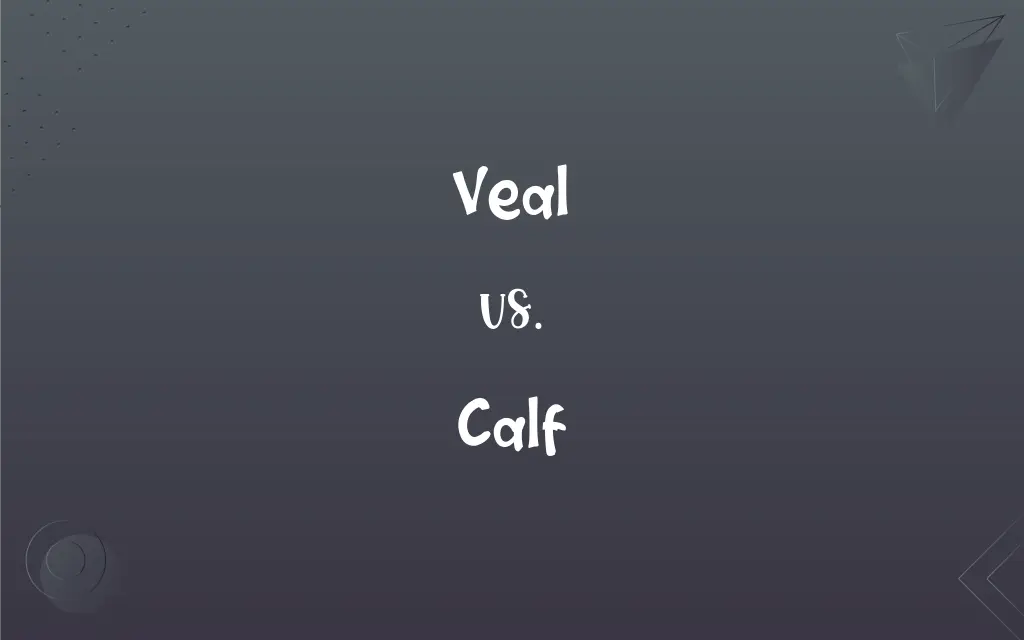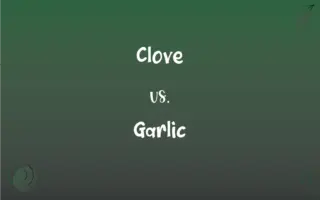Veal vs. Calf: What's the Difference?
By Aimie Carlson & Janet White || Updated on March 4, 2024
Veal refers to the meat from young cattle, prized for its tenderness and mild flavor, whereas a calf is a young bovine animal itself, not specific to its use as food.

Key Differences
Veal is the culinary term for meat derived from calves, typically slaughtered between 16 to 18 weeks old, resulting in tender and pale-colored meat. This delicacy is distinguished by its soft texture and subtle flavor, making it a favorite in various cuisines, particularly European. On the other hand, a calf is a young bovine of either sex, usually under one year old, and represents the animal in its living state, not necessarily destined for veal production.
The production of veal involves specific rearing practices aimed at maintaining the desired meat quality, which includes controlled feeding and sometimes restricted movement. These practices contribute to the distinctive characteristics of veal meat, such as its tenderness and light color. In contrast, calves not raised for veal might be reared under different conditions, destined for dairy production or to grow into adult cattle for beef.
Veal is often used in high-end culinary dishes and can be prepared in various ways, including roasting, grilling, and sautéing. It's particularly famous in dishes like veal scallopini, veal Parmesan, and osso buco. Calves, however, are valued for more than just meat; they are integral to the dairy industry, with female calves eventually becoming milk producers and male calves often raised for beef or veal.
The ethical considerations surrounding veal production, including concerns about animal welfare and rearing conditions, have led to significant changes in the industry. Many producers now adopt more humane practices, allowing calves more freedom to move and a more natural diet. This shift reflects a growing consumer demand for ethically sourced and humanely raised meats.
While veal is a specific category of meat that comes from young cattle, the term calf encompasses a broader scope, referring to young bovine animals in general, without specifying their end use. This distinction highlights the difference between an animal in its juvenile stage and the specific culinary use of its meat.
ADVERTISEMENT
Comparison Chart
Definition
Meat from young cattle, known for its tenderness and mild flavor.
A young bovine animal, either male or female, typically under one year old.
Usage
Culinary term for the meat used in various dishes.
Refers to the animal itself, not specifically its meat.
Age of Animal
Slaughtered between 16 to 18 weeks old for veal production.
Can be referred to as a calf until it reaches one year of age.
Culinary Role
Prized in high-end cuisine for its soft texture and subtle flavor.
Not used in culinary context; refers to the living animal.
Ethical Considerations
Veal production has faced criticism for animal welfare concerns, leading to changes in rearing practices.
Rearing practices for calves vary widely, depending on their intended use (dairy, beef, or veal).
ADVERTISEMENT
Veal and Calf Definitions
Veal
Sourced from calves raised specifically for this purpose.
The veal on the menu comes from specially reared calves.
Calf
A young bovine animal.
The farmer's new calf was only a week old.
Veal
Subject to ethical considerations.
Modern veal farming practices emphasize animal welfare.
Calf
Can be male or female.
The dairy farm has both male and female calves.
Veal
Prized for its soft texture.
Veal is often used in fine dining for its subtle flavor.
Calf
Integral to dairy and beef industries.
Female calves may be raised to join the dairy herd.
Veal
Tender meat from young cattle.
The chef prepared a delicate veal cutlet.
Calf
Raised under a variety of conditions.
The calves have ample space to roam on the pasture.
Veal
Used in various cuisines.
Veal scallopini is a popular Italian dish.
Calf
A young cow or bull.
Veal
The meat of a calf.
Calf
One of the young of certain other mammals, such as moose, elephants, or whales.
Veal
Also veal·er (vēlər) A calf raised to be slaughtered for food.
Calf
Calfskin leather.
Veal
The flesh of a calf (i.e. a young bovine) used for food.
Calf
A large floating chunk of ice split off from a glacier, iceberg, or floe.
Veal
The female genitalia. en
Calf
An awkward, callow youth.
Veal
To raise a calf for meat production.
Calf
The fleshy muscular back part of the human leg between the knee and ankle.
Veal
The flesh of a calf when killed and used for food.
Calf
A young cow or bull.
Veal
Meat from a calf
Calf
Leather made of the skin of the calf; especially, a fine, light-coloured leather used in bookbinding.
Calf
A young deer, elephant, seal, whale or giraffe also used of some other animals.
Calf
A chunk of ice broken from a larger glacier, ice shelf, or iceberg.
Calf
A small island, near a larger island.
The Calf of Man
Calf
A cabless railroad engine.
Calf
An awkward or silly boy or young man; any silly person; a dolt.
Calf
(anatomy) The back of the leg below the knee.
Calf
The muscle in the back of the leg below the knee.
Calf
The young of the cow, or of the Bovine family of quadrupeds. Also, the young of some other mammals, as of the elephant, rhinoceros, hippopotamus, and whale.
Calf
Leather made of the skin of the calf; especially, a fine, light-colored leather used in bookbinding; as, to bind books in calf.
Calf
An awkward or silly boy or young man; any silly person; a dolt.
Some silly, doting, brainless calf.
Calf
A small island near a larger; as, the Calf of Man.
Calf
A small mass of ice set free from the submerged part of a glacier or berg, and rising to the surface.
Calf
The fleshy hinder part of the leg below the knee.
Calf
Young of domestic cattle
Calf
The muscular back part of the shank
Calf
Fine leather from the skin of a calf
Calf
Young of various large placental mammals e.g. whale or giraffe or elephant or buffalo
Calf
Not specified for culinary use.
Calves on the farm are not necessarily destined for veal production.
FAQs
At what age are calves typically slaughtered for veal?
Calves are usually slaughtered between 16 to 18 weeks old for veal production.
Why is veal considered a delicacy?
Veal is prized for its tender texture and mild flavor, making it a favorite in fine dining.
How has veal production changed in response to animal welfare concerns?
Many veal producers have adopted more humane practices, such as allowing calves more freedom and a natural diet.
What determines whether a calf is raised for veal, beef, or dairy production?
Factors include the calf's sex, breed, and the specific needs and practices of the farm.
Is veal more expensive than beef from older cattle?
Yes, veal is often more expensive due to specialized rearing practices and the premium placed on its tenderness and flavor.
What is the main difference between veal and calf?
Veal refers to the meat from young cattle, while a calf is the young bovine animal itself.
Can all calves become veal?
Not all calves are raised for veal; some are reared for dairy production or to become beef cattle.
What are some ethical concerns associated with veal production?
Ethical concerns include the rearing conditions and welfare of the calves raised for veal.
Can veal come from any type of cattle?
Veal typically comes from dairy breeds, as the meat from these young animals is particularly tender and pale.
Are there different types of veal based on the age of the calf?
Yes, veal types can vary, such as "bob veal" from calves only a few weeks old and "rose veal" from older calves, which is darker in color.
How can consumers ensure they're buying ethically sourced veal?
Look for certifications or labels indicating humane rearing practices, such as free-range or pasture-raised, and consider sourcing from reputable farms.
How is veal typically prepared in cuisine?
Veal can be roasted, grilled, sautéed, and is featured in dishes like veal Parmesan and osso buco.
Do calves have a role in the dairy industry?
Yes, female calves may be raised to become part of the dairy herd, while male calves might be reared for meat.
Why do some people choose not to eat veal?
Ethical concerns about the traditional rearing methods of calves for veal production lead some to avoid veal.
What are the environmental impacts of veal production?
Veal production, like all livestock farming, has environmental impacts, including resource use and greenhouse gas emissions, though these can vary based on farming practices.
Can veal be part of a healthy diet?
Veal can be a lean source of protein and nutrients when consumed in moderation, fitting into a balanced diet.
How do cooking methods for veal differ from those for older beef?
Veal, being more tender, often requires shorter cooking times and gentler methods to preserve its texture and moisture.
Do all countries produce and consume veal?
Veal consumption varies globally, with higher popularity in European countries; some cultures and regions have less tradition of veal consumption.
What does the term "milk-fed veal" mean?
"Milk-fed veal" refers to calves that are fed primarily a milk-based diet, contributing to the pale color and tender texture of the meat.
How is the veal industry regulated to ensure animal welfare?
Regulations vary by country, but many have established standards for veal production that address housing, diet, and overall care to improve welfare.
About Author
Written by
Aimie CarlsonAimie Carlson, holding a master's degree in English literature, is a fervent English language enthusiast. She lends her writing talents to Difference Wiki, a prominent website that specializes in comparisons, offering readers insightful analyses that both captivate and inform.
Co-written by
Janet WhiteJanet White has been an esteemed writer and blogger for Difference Wiki. Holding a Master's degree in Science and Medical Journalism from the prestigious Boston University, she has consistently demonstrated her expertise and passion for her field. When she's not immersed in her work, Janet relishes her time exercising, delving into a good book, and cherishing moments with friends and family.































































